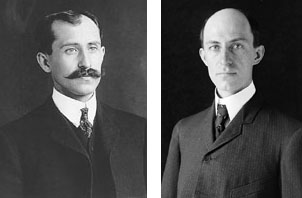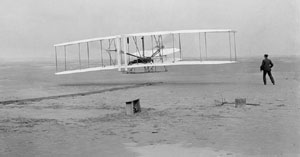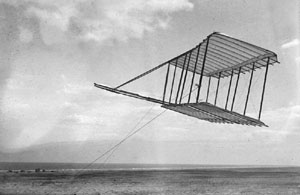 |
|
|
|
100 YEARS OF POWERED FLIGHT
How The Wright Brothers Began It All
(From Fall 2003 21st Century, partial text)
by Carl Osgood
|
|
|
|
American ingenuity, persistence, and most of all, a love of discovery led to man’s first powered flight.
|
|
|
|
|
|
Today, dear reader, you take it for granted that man can fly. Just 100 years ago this was not so. We will explore here how it is that man lifted himself out of the mud and began to soar.
The pioneers of manned flight are Orville and Wilbur Wright. By far and away, their insights into the barriers man had to transcend to lift himself up into the air were unique. When the Wright brothers’ historic flight occurred on December 17, 1903, they “flew” only 120 feet and were a mere 10 feet off the ground. But to make this leap for mankind, it required ingenuity and love of discovery.
The problems to solve were not small. Just before the turn of the 20th Century, there were a number of experimenters flying man-carrying gliders. But it was the tragic outcome of one such experiment which impelled the Wright brothers to solve this great challenge.
On September 18, 1901—more than two years before the historic first powered flights of Wilbur and his brother Orville at Kitty Hawk, North Carolina and more than five years after they first became seriously interested in the problem of controlled heavier than air flight—Wilbur Wright described to a meeting of the Western Society of Engineers in Chicago the crucial problems to be solved:
|
|
|
|
 |
|
Orville Wright at 34 (left)
Wilbur Wright at 38 (right)
|
|
|
|
|
|
The difficulties which obstruct the pathway to success in flying machine construction are of three general classes:
(1) Those which relate to the construction of the sustaining wings; (2) Those which relate to the generation and application of the power required to drive the machine through the air; and (3) Those relating to the balance and steering of the machine after it is actually in flight.1
Although the breakthrough achieved by the brothers would be in the solution to the third problem addressed by Wilbur—the problem of stability and control in powered flight—they would also considerably advance the knowledge in the other two areas, as well, in the march to their great achievement.
|
|
|
|
|
 |
|
Orville Wright is at the controls, with his brother Wilbur running alongside, in the first powered flight, Dec. 17, 1903.
(Library of Congress)
|
|
|
|
|
|
The Bishop’s Sons
Wilbur and Orville Wright were the two youngest sons of Bishop Milton Wright of the Church of the United Brethren in Christ. In addition to fathering the inventors of the airplane, Bishop Wright is also known as one of the most controversial figures in the history of that church. He had a commitment to principle and piety that would become an identifiable trait in his two famous sons.
As a father of the church, Bishop Wright travelled widely to tend to its various congregations, and the family moved frequently during the post-Civil War period. Wilbur was born on a farm in Millville, Indiana, on April 16, 1867, and Orville was born on August 19, 1871, in the house the family would come to occupy for more than 40 years, at 7 Hawthorne St. in Dayton, Ohio. Two older brothers had grown up and were out of the house by the time Wilbur was a teenager, and a sister, Katharine, was born three years after Orville.
Orville would recount in later years that he and Wilbur’s first interests in flight began when they were children, with powered rubber-band-helicopter toys that their father would bring home for them from trips around the country. Orville and Wilbur would build duplicates of these toys and bounce them off the ceiling. For reasons that they did not yet understand, however, larger versions of these toys did not work so well.
|
|
|
|
|
 |
|
The 1900 glider flying as a kite. The Kitty Hawk Lifesaving station and the Weather Bureau are in the background at left.
(Library of Congress)
|
|
|
|
|
Both boys loved to solve problems that seemed insoluble to others. The more difficult the problem, the more they saw it as a challenge. Delving into the unknown was such a joy for them that Orville once said “I can remember when Wilbur and I could hardly wait for morning to come to get at something that interested us. That’s happiness!”2
Putting their ingenuity to work, the boys entered the printing business soon after high school. Orville designed and then built a printing press for this enterprise. At first they did contract printing for other people, and soon one of their biggest customers during the early 1890s was father Milton’s church. They also tried the newspaper business, and although their two newspapers, the West Side News and the Evening Item were considered to be of high quality, Dayton already had 12 daily newspapers, so the Wrights soon returned to contract printing.
Branching out into other areas, they also opened a bicycle business. Bicycling was the fastest growing sport in the country at that time, and their repair shop soon led them into building bicycles of their own design, often with tools of their own construction, such as the lathe driven by a one cylinder gasoline engine built by Orville. The bicycle shop would provide the livelihood that would allow them to carry out their aeronautical experiments. . . .
Carl Osgood, an Air Force veteran, is a correspondent for Executive Intelligence Review in Washington, D.C., and at the Pentagon.
|
|
|
|
|
|
|